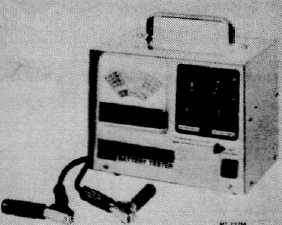BATTERY
STEP 3.
BATTERY CAPACITY (LOAD) TEST
Perform battery capacity (load) test using battery test
equipment available commercially.
NOTE - Always follow manufacturer’s Instructions
and precautions when using battery test equipment.
A satisfactory capacity (load) test can be made only
when battery electrolyte equals or exceeds 1.225 spe-
cific gravity when corrected to 26.'7C (80°F).
MT-23258
Figure 13 -- Battery Tester
a.
Disconnect battery cables from battery.
(Disconnect ground cable first.)
b.
Connect tester leads to battery terminals follow-
ing tester manufacturer's instructions.
c.
Apply specified test load to battery for 15 sec-
onds or as specified in tester instructions.
Test load (amperes) is equal to one-half of the
cold cranking amperes at - 1 8°C (9°F) rating of
the battery.
Specified test loads for "Fleetrite" and "Interna-
tional" batteries are listed in SPECIFICATIONS.
d.
Note voltage reading after 15 seconds (or other
specified time interval) under load. Then remove
load.
If voltage reading under load is less than per-
missible minimums at temperatures listed in Ta-
ble 5, replace the battery.
If voltage meets or exceeds permissible mini-
mum listed in Table 5, clean the battery and
return it to service.
CHARGING
CAUTION - BEFORE ATTEMPTING TO CHARGE A
BATTERY, BE AWARE OF ALL THE PRECAUTIONS
TO BE FOLLOWED DURING THE CHARGING OP-
ERATION. REFER TO BATTERY CHARGING PRE-
CAUTIONS UNDER PRECAUTIONS.
ALWAYS FOLLOW BATTERY CHARGER MANU-
FACTURER’S INSTRUCTIONS.
WHEN POSSIBLE, USE A BATTERY CHARGER WITH
ALTERNATOR OR POLARITY PROTECTION THAT
PREVENTS CHARGING THE BATTERY IN REVERSE
POLARITY.
Two methods of recharging a battery, the Slow Charge
Method and the Fast Charge Method, are described
below.
The charge a battery receives is equal to the charge rate
in amperes multiplied by the time in hours. Thus a five
ampere rate applied to a battery for ten hours would be a
50 ampere-hour charge to the battery. To fully recharge
a battery, you must replace the ampere-hours or
ampere-minutes removed from it, plus an extra
20%charge. This is due to the fact that batteries are not
100% efficient on recharging.
The Battery Charging Guides, Tables 6 and 7, show
approximately how much recharge a fully discharged
battery requires. For partially discharged batteries, re-
duce the charging current or charging time (ampere
hours) accordingly.
For example: If the battery is 25% charged (75% dis-
charged), reduce charging current or time by one-fourth
(1/4). If the battery is 50% charged, reduce charging
current or time by one-half (1/2).
TABLE 5
Ambient Temperature
21o C
16o C
10o C
4o C
-1o C
-70o C
- 12o C
-18o C
(70o F) &
(60o F)
(50o F)
(40o F)
(30o F)
(20o F)
(10o F)
(0o F)
above
12 Volt Battery
9.6
9.5
9.4
9.3
9.1
8.9
8.7
8.5
6 Volt Battery
4.8
4.75
4.7
4.6
4.5
4.4
4.3
4.2
Minimum Permissible Voltage
CTS-4111B - Page 12

